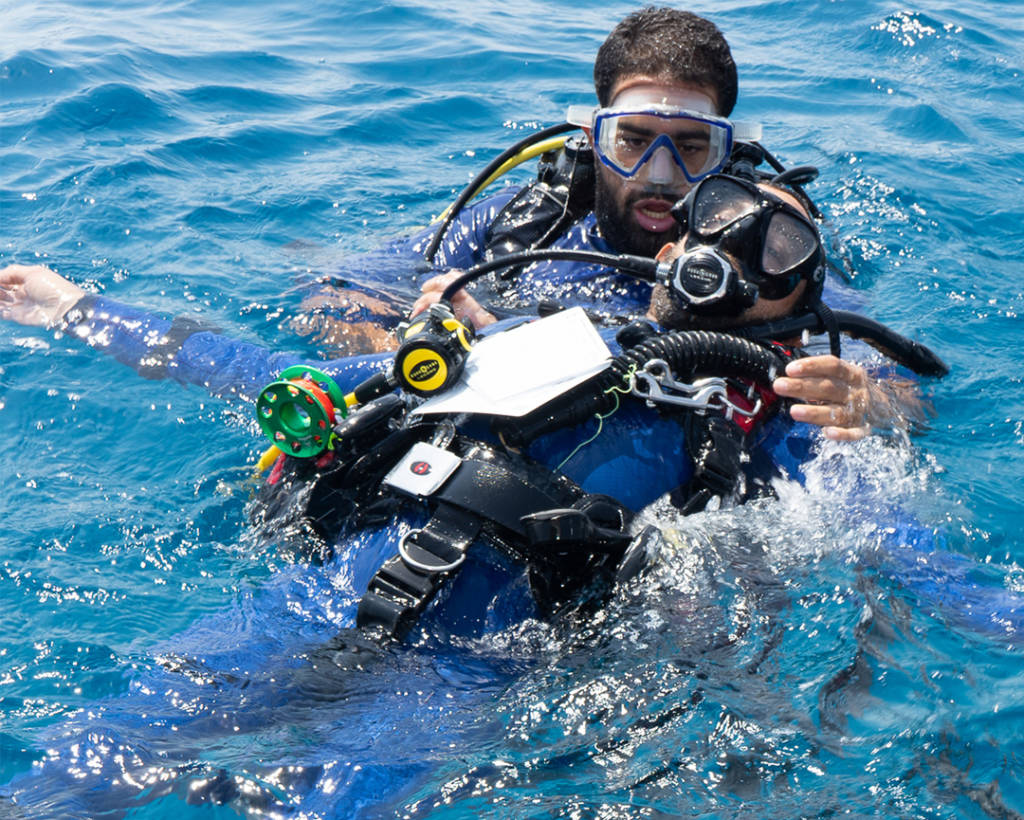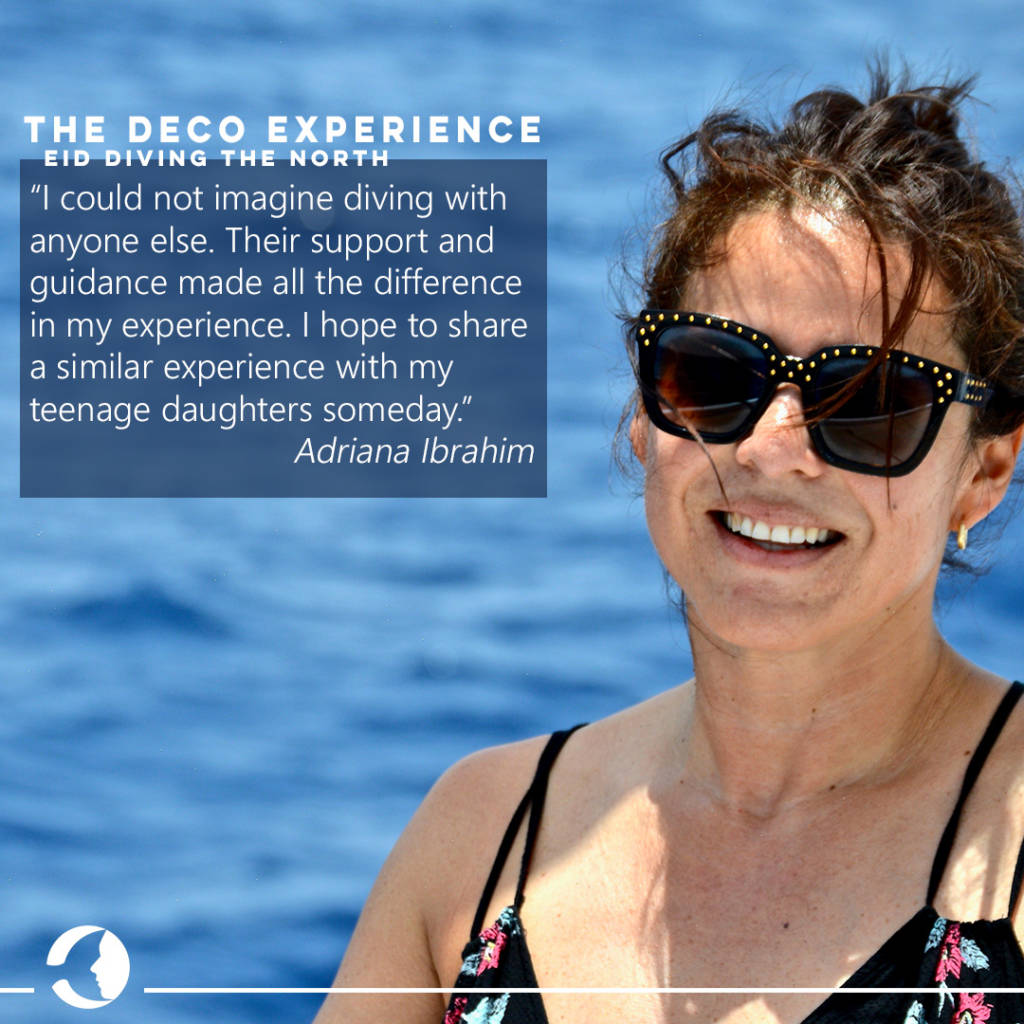
RESCUE DIVER & EFR COURSE & CERTIFICATION
While it is commonly agreed that scuba diving is a safe activity, it is not without risk. Throughout your training, you’ve learned about the dangers of diving and learned skills to ensure you ascend safely from every dive. Performing dive briefings and equipment checks with your buddy, diving within your limits, and even diving with an experienced guide are all ways we can limit the risks of diving. But even when we follow these important safety measures, we still cannot guarantee a diving related accident will not happen. Would you know how to respond if a diver lost their buddy, had a panic attack underwater, or suffered from decompression illness? PADI’s Rescue Diver Course teaches divers the skills to prevent and respond to diving related incidents.
If an accident does occur, we cannot provide an appropriate level of medical care without having a basic understanding of first response care. As such, the rescue course also requires Emergency First Response (EFR) training. During your first response training not only will you learn how to provide essential care to victims of diving-related accidents, but you will also learn how to provide essential care to common injuries that may take place at home, school, or your work environment. The EFR course is often considered one of our most fun and valuable courses as it involves interactive role-play to teach safety skills that apply to our everyday lives.
WHY DO THESE PADI COURSES?
There are many different training organizations throughout the world, so why pick the EFR ‘Primary and Secondary Care’ and the PADI ‘Rescue Diver course’? PADI stands for the Professional Association of Diving Instructors and is the world’s leading scuba diver training organization. With more than 50 years of training experience certifying over 27 million divers, PADI has developed a comprehensive curriculum featuring books, videos, and materials in almost every language. Enrolling in a PADI course taught by PADI Instructors ensures that you are learning in an industry-leading environment in regards to safety and quality of teaching. Lastly, their certifications are acknowledged worldwide, making it possible for you to use your PADI certification around the globe. We are proud to be a part of the PADI team and transform lives through scuba diving.
Completing the PADI Rescue Diver course and Emergency First Response (EFR) Primary and Secondary Care course will train you to become a more safe diver. Combined, these courses teach the steps of preventing diving-related injuries, and in the unlikely event they occur, how to respond appropriately. PADI’s step-by-step methodology for assessing situations will help you gain the confidence to provide first response care in a wide variety of emergency situations.
DOING THE TRAINING ON YOUR HOLIDAY
If you are a diver looking to prioritize safety and comfort in the water, we highly recommend completing the Rescue and Emergency First Response course on your holiday. Over four days, you will enjoy sunshine and warm water conditions as you learn the skills to prevent and respond to diving-related accidents. The course may be shortened if you already have first response training and/or complete the theory using PADI’s eLearning modules. After the conclusion of your course, we also invite you to stay and enjoy several days of exploring our local reefs.
We offer a wide range of destinations within Egypt and throughout the world that are great for completing your Rescue course. Please contact our team to learn more about the different destination options we have.
YOUR TRAINING WITH DECO DIVERS
Diver safety is our number one priority at Deco Divers. We believe we have a responsibility to keep our divers safe. If you have dove with use before, you’ve seen our team conduct current and dive site checks, deliver extensive dive briefings and emphasize buddy checks before every dive. What you haven’t seen are the steps we take behind the scenes to ensure we are prepared to provide first response care. Besides preparing an emergency action plan and a fully stocked medical kit for our events, our team works with PADI Course Director Ahmed Mamdouh to ensure we are prepared to provide the best first response care if needed.
When you sign up to complete your rescue and first response training with our team, you are signing up to learn from a team of instructors that always place safety first. Our team takes pride in delivering this course in a fun, informative, and practical manner. If you have any questions about the Rescue Diver or Emergency First Response course, please feel free to contact us.
DO YOU NEED BOTH COURSES?
To receive a rescue diver certification, divers need to have valid emergency response training. That training must have been completed within the last 24 months by either PADI’s Emergency First Response course or a similar course from another qualifying organization. Divers who have proof of their emergency response training do not need to complete the EFR course. Please contact us if you’d like help determining if you need EFR training.
In addition to the Rescue Diver and Emergency First Response courses, we also suggest the Emergency Oxygen Provider specialty course. In the unlikely event of a dive accident, oxygen is likely to be administered during first response care. Through this specialty, you will learn to immediately recognize scuba diving illnesses treatable with emergency oxygen and be prepared to offer aid. More information about this specialty course can be found on our specialty page, or please contact us with any further questions.
WHAT YOU NEED TO START THE EFR & RESCUE DIVER COURSES
During the Emergency First Response course (EFR) you will learn the skills to provide primary (CPR) and secondary (first aid) care. While the course is required to become a rescue diver, the skills you will learn will allow you to provide first response care at home, school, work, and in your community. There are no age restrictions to complete the course and it is open to both divers and non-divers alike.
To enroll in the Rescue Diver course, you must be at least 12 years old with an Advanced Open Water Diver certification, or an Adventure Diver who completed the underwater navigation adventure dive, you may enroll in the Rescue Diver course. You will either need to provide proof of completing first response training within the last 24 months or enroll in PADI’s EFR course.
PADI RESCUE DIVER COURSE
Why do divers describe the Rescue Diver course as the most challenging, yet most rewarding course they’ve taken? Well, it’s because not only do you learn to prevent and manage problems in the water, but you also become more confident in your skills as a diver. And even though you’ll be learning serious skills like how to respond to a panic diver in the water or how to ascend an unconscious diver to the surface, the course uses lots of role-play that naturally lends itself towards laughter and fun.
The theory portion of the Rescue course can either be completed using classroom based instruction or through PADI’s elearning modules. If you choose to use classroom based instruction, your instructor will provide you with the PADI Rescue Diver Manual. Like all PADI Manuals, the book is broken into chapters that contain both quick review questions and knowledge reviews to help assess your understanding. Some of the topics you can expect to learn are how to prepare for a diver emergency, accident management, common equipment problems, and responding to diver emergencies. At the conclusion of the course, there is a comprehensive theoretical exam.
E-LEARNING BY PADI
As an alternative to the book, PADI e-learning utilizes interactive modules to study the same knowledge and information through listening, reading, and responding. To complete your theory using e-learning, the only thing you need is an internet connection. E-learning provides you with the flexibility to start anywhere at any time, and to progress at your own time and pace. We highly recommend completing your e-learning prior to the start of your rescue diver course.
To learn more about e-learning, send us a message and we are happy to help you.
After completing your knowledge development, it’s time to jump in the water and practice our rescue skills. Working alongside your instructor, you will practice 10 different rescue exercises. Those rescue exercises include responding to a tired diver, panicked diver, from shore or a boat, distressed diver underwater, missing diver, surfacing an unresponsive diver, unresponsive diver at the surface, exiting an unresponsive diver from the water, providing first aid for pressure related injuries and oxygen administration, and response from shore or a boat to an unresponsive diver at the surface. Depending on the size of your class, it is likely you will get to practice being both the responder and the victim to many of these situations; which can be quite entertaining!
The rescue course concludes with two rescue scenarios that combine many of the skills learned in your 10 rescue exercises. For the first scenario, you will respond to an unresponsive diver underwater by searching and finding a missing diver during an accident simulation. In the second scenario, you will respond to an unresponsive diver on the surface and provide care as you tow and remove them from the water.
EMERGENCY FIRST RESPONSE (EFR) COURSE
No matter how hard we try to prevent accidents, they still happen. Are you prepared to respond? PADI’s EFR course will teach you the skills to provide primary care (CPR) and secondary care (first aid) to accident victims that meet international compliance guidelines. You will build your confidence in providing care when faced with medical emergencies by learning and practicing the same patient care techniques and principles used by medical professionals, but at the layperson level. Some of the specific skills you can expect to learn are scene and injury assessment, barrier use, CPR, bleeding, shock, and spinal management, bandaging, and splinting. Both the Primary Care and Secondary Care portions of this course focus on providing care through a combination of knowledge development, skill development, and realistic scenario practice.
The EFR course has two main parts – knowledge development and practical training. In the knowledge development portion of the course, you can expect to learn the principles of emergency first response by reading the EFR Manual and watching the corresponding videos. In combination, the manual and videos explain in detail how to identify a potential victim, assess the scene, and respond with the appropriate level of care. Like your other PADI Courses, each section of the manual contains knowledge reviews and there is a theoretical exam at the end of the course. You will learn the duties and responsibilities of an emergency first responder, and the skills and different techniques to respond to injury, bleeding, broken bones, splinting, choking, and non-responsive individuals.
Once you have a broad understanding of providing primary and secondary care, in the second portion of the course you will work alongside your instructor as you complete skill development and scenario practice sessions.
To provide primary care (CPR), you will learn how to assess the scene, use barriers, conduct a primary assessment, provide Cardiopulmonary Resuscitation (CPR), provide serious bleeding management, shock management, spinal injury management, conscious and unconscious choking management. The secondary skills you will learn are injury assessment, illness assessment, bandaging, and splinting for dislocations and fractures.
GETTING A CERTIFICATION FOR EFR & RESCUE DIVER
Your Rescue Diver course is completed after you successfully finish Emergency Response Training, 5 knowledge reviews, theoretical exam, and pass the two rescue scenarios. Upon completion of these, we will submit your application to PADI and they will email you a digital certification card.
Your certification card proves you are a Rescue Scuba Diver and can be used to continue your diving adventures at dive centers throughout the world.

WHAT IS THE NEXT COURSE?
Once you’ve completed your Rescue Diver course, there are several different options for you to continue to enhance your diving skills. As a Rescue Diver, you may want to work towards becoming a Master Scuba Diver. A Master Scuba Diver is the top recreational diver certification. It is achieved when you have rescue diver training and 5 PADI Speciality Certifications. After completing your first response training, we highly recommend the PADI Emergency Oxygen Provider course. For information on this specialty and the other available specialties, please take a look at our specialty page.
If you envision yourself as a future leader in the diving industry, we suggest starting your professional career with the PADI Divemaster course. Through your training, you will learn the skills to assist divers, assist instructors with recreational courses, and lead dives. To learn more, please take a look at our PADI Professional page.

